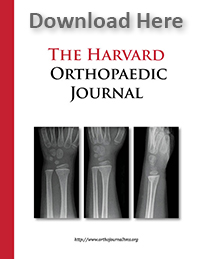Original Submissions
Current Issue: Volume 14 | ![]() PDF
PDF
Reengineering Operating Room Workflows: Surgeon to Central Processing Staff Interventions Improve the Mechanics of Safe Surgical Care Delivery and Decrease Infection Rates
1Massachusetts General Hospital Hand and Upper Extremity Fellowship, Massachusetts General Hospital,
Boston, MA
2Beth Israel Deaconess Medical Center, Boston, MA
3Harvard Combined Orthopaedic Residency Program, Massachusetts General Hospital, Boston, MA
4Department of Orthopaedic Surgery, Beth Israel Deaconess Medical Center, Harvard Medical School, Boston, MA
Keywords: Operating Room Workflows, Safety Culture, Central Processing
Abstract
Post-operative infections in orthopaedic surgery can be limb and life threatening. This is a case of a directed workflow intervention. We initiated a multifaceted strategy to decrease postoperative infections involving one type of surgical implant. After workflows were reengineered, we dropped from a 25% infection rate in the pre-intervention time period to a 0% infection rate in the post-intervention monitoring period. Our experience demonstrated that even with today's most technologically advanced surgical equipment, it still comes down to effective human-to-human interaction to have a significant impact on the safe delivery surgical care.
Introduction
Post-surgical median total length of stay for open reduction and internal fixation from fractures nearly quadruples when infections are present (3.5 to 15 days) and the median total health care cost more than doubles from $2,481 to $6,104.1 The safe delivery of orthopaedic surgical care is multifactorial yet critical to avoid complications such as infection. Safe care relies on hospital care-delivery systems, buy-in from all individuals into the institutional safety culture, and an active effort to identify shortcomings and improve upon them. In our hospital we had one example involving surgical site infections. By clearly defining the problem, identifying educational objectives and reengineering workflows, we were able to make a significant improvement in a specific safety problem impacting our patients.
Methods
We set out to clearly define the problem and then make a pointed intervention while monitoring infection rates and reoperation rates.
The Problem
Over a sixty day period, we had 3 infections out of 12 cases using a specific instrument designed for the management of periarticular tibia or femur fractures about the knee: the Synthes Less Invasive Stabilization System (LISS)2 or analogous lateral locked plating systems. Each infection had a significant impact on our patients’ post-operative health. All patients received a peripheral percutaneous indwelling central catheter to receive intravenous antibiotics for six weeks. Two of our patients returned to the operating room for management of their infections in addition to the IV antibiotics. During this time period we found ourselves opening extra kits during operating room set up because some equipment was visibly contaminated even though it had undergone our standard processing protocols. We were concerned that the spike in infections could potentially be related to deficiencies in the processing and cleaning of the surgical equipment.
The Intervention
Taking into account the increase in infections over such a short time interval using this type of instrumentation and the multiple episodes of contaminated materiel discovered during surgical set ups, we arranged for an educational session to address the problem. The first event was a training session where the surgical team informed the central processing unit about the severity of the problem, the indication for the use of these instruments in severely injured patients, and the technical aspects of the equipment and surgical procedures, emphasizing how contaminated material delayed care, introduced the risk in infection, and increased cost due to the need to open multiple system kits to have a complete set of properly cleaned instruments (Figure 1). In turn, the central processing team and operating room management set up an educational event for the surgeons and surgical team to learn about the central processing environment, the high instrument volume demand, their physical plant limitations, and other standard operating procedures (Figure 2). The surgical team then set up a mock surgery for which the entire group was invited into an operating room which was closed down during routine business hours for the purpose of training all staff about the intricacies of the application of the LISS on tibia fractures (Figure 3). The LISS over other lateral locked plating systems was selected for the educational intervention because it was the most complex system and offered several opportunities to show the staff how meticulous attention to detail impacted each step of the case and the eventual outcome of the patient. The large number of cannulated tools in the LISS tray increases the risk of contamination if not properly processed and cleaned. Several breaks in action were done to show each group of attendees how their own actions are critical links in the chain of safe patient care. Every member of the team was encouraged to speak up and tell the group how their actions affected everyone’s workflows (Figure 4). Data was monitored for two months after the intervention to mirror the initial problem window and give staff feedback over a comparable time frame.
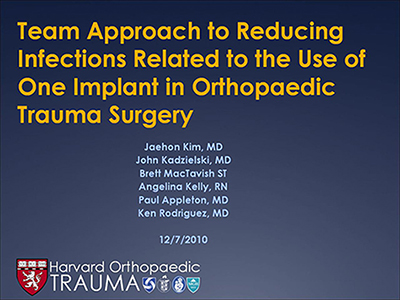 This is the title page of the presentation given to the entire operative team and the surgical equipment processing personnel.
This is the title page of the presentation given to the entire operative team and the surgical equipment processing personnel.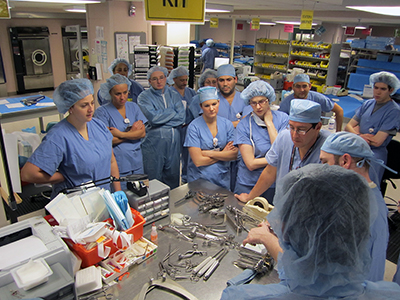 The surgical team and the central processing team gathered together in central processing as each individual demonstrated how he carried out his tasks. We discussed how workflows could be optimized for efficiency and safety.
The surgical team and the central processing team gathered together in central processing as each individual demonstrated how he carried out his tasks. We discussed how workflows could be optimized for efficiency and safety.All Rights Reserved. Permission For Use Required.
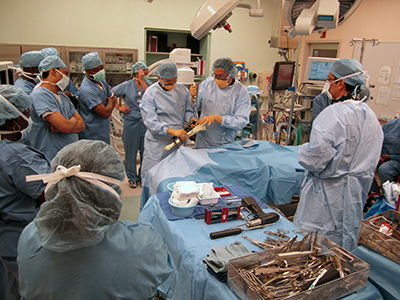 With the full support of the operating room administration, we shut down an operating room in the middle of the day and ran a mock surgery where the surgical team and the central processing team could see the results of the work and understand how everyone’s role was critical in the safe delivery of patient care.
With the full support of the operating room administration, we shut down an operating room in the middle of the day and ran a mock surgery where the surgical team and the central processing team could see the results of the work and understand how everyone’s role was critical in the safe delivery of patient care. 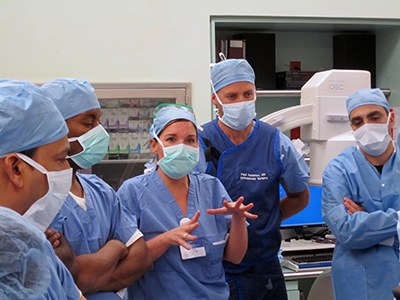 Everyone made a point of speaking up about how other people’s performance affected the care of the patient. A point was made to establish a safe environment in which people felt comfortable sharing their thoughts.
Everyone made a point of speaking up about how other people’s performance affected the care of the patient. A point was made to establish a safe environment in which people felt comfortable sharing their thoughts.All Rights Reserved. Permission For Use Required.
Results
Lessons Learned From The Intervention
- 1. All equipment from 18 operating rooms each doing several cases a day with several equipment trays was processed by only one person in the evenings.
- 2. Only one sink was available to wash all of the operating room equipment.
- 3. Soap dispensers at the operating room pre-wash station where instruments are first cleaned before being submitted to central processing were defective.
- 4. Too few ultrasonic sterilizers and autoclaves were present to process the equipment because they have fixed run times and predispose to bottle neck and delayed processing.
- 5. New Instrument tracking system were helping to keep track of different instruments at they were cleaned but the system implementation created extra initial work for the processing teams who were already short-staffed.
- 6. Instruments were sent down to processing in a way that makes it hard for them to stay organized, resulting in added sorting steps, increasing complexity, creating an opportunity for error, and creating a safety risk for processing staff who can get injured with the instruments.
- 7. No pipe cleaners were available to clean the LISS cannulas.
- 8. Three individuals were involved in completing each sterile kit but only one person's initials were on it for feedback and tracking, thus losing a level of accountability. The person who signed off on it was the first person involved in processing it, not the last.
- 9. Processing personnel were getting injured on instruments which were not put back in their proper sterilization position in the equipment box as operative surgical techs are rushing to clear their tables and clean the room between cases to hasten operating room turnover.
- 10. Specialized orange color trays have now been developed with a cleaning solution to pre-clean the insides of the cannulas before blood dries on their inner surfaces.
Safety Results And Infection Rates
There were 12 patients in the 60 days leading up to this intervention who were treated with the LISS or an analogous locked lateral plating system. Three patients experienced post-operative infections. In the two months after the intervention, 12 patients were treated with similar instruments with no resultant infections. In the immediate 2 months after intervention, the infection rates dropped from 25% to 0%. A Pearson Chi-square test was used to determine if the patients treated after the team workflow intervention significantly different infection rates than those treated before the before the intervention. Despite its clinical impact, this early trend towards improvement was not statistically significant (χ2 = 3.429, p = 0.064). Results are depicted in Table 1. There was no significant difference in the ratios of LISS or other lateral locked plating system during that time (χ2 = 0.667, p = 0.414).

Work Flow Implications
The operating room teams and central processing teams have now begun actively setting each other up for success. The teams in the OR take extra time to pre-clean the instruments and arrange them such that they do not create extra work or injury risk for the people in central processing. The staff in central processing, despite limited resources, can now employ their time and their resources more effectively. A culture of mutual respect and safety has developed, which has decreased the infection rate in our patients during the study period from 25% to 0%, clinically important while not a statistically significant result.
Discussion
Reported infection rates of closed and low-grade open proximal tibia fractures rage from 0% to 5% when treated with the LISS.3-5 Orthopedic infections require aggressive debridement and often multiple operations followed by prolonged courses of intravenous antibiotics. They contribute to global antibiotic resistance, long-term disability, and high medical costs. Patients are unable to walk, drive, work, or otherwise engage in productive or recreational activities for months at a time. They are devastating to patient finances and result in significant social and family difficulties. In the most severe cases they may result in amputations and even mortality.
Using fracture specific technology like locked plating systems such as the LISS has revolutionized fracture care. It has allowed for control of difficult fractures with less hardware and smaller surgical exposure to reduce soft tissue trauma and improve union rates. However it has increased the technical complexity of surgery and reliance on complex instrumentation systems. Safe and successful treatment with locked plating systems such as the LISS requires a team approach to reengineer workflows and educate all team members so that the intricacies of the new instruments systems, their proper maintenance and cleaning, and their proper clinical use are addressed.
Limitations of this study are that there are no objective measures to monitor the direct person-to-person impact of the intervention. The time period monitored is a small window, but this was selected to give the staff rapid feedback on the intervention. Also, the total number of cases is low but this specific procedure has limited indications.
Conclusion
Our experience shows that even when dealing with today's most technologically advanced surgical equipment, effective human-to-human interaction is essential for the safe delivery of surgical care. Maintaining and cultivating these relationships facilitates ongoing education and safety innovation. We have shown the pitfalls of the application of frontline technologies but have also shown that staff working together with mutual respect and a rich safety culture can overcome and master the intricacies of each evolution in healthcare. Orthopaedic researchers have shown that safety climate, a snapshot of a group’s safety culture, is one area in which our specialty is lacking when compared to other high-risk environments like naval aviation.6 In an environment where safety reports are filed “against” people rather than for the improvement of a system, it is important to bring the focus back on interventions that improve relationships and culture. As leaders in healthcare struggle to innovate and obtain market share in their region, we hope that this case series serves as a reminder that in today's technically advanced environment, healthcare delivery is still about people caring for other people.
References
